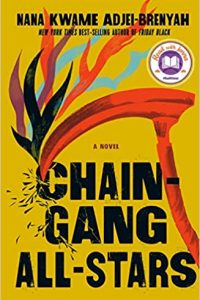Gary K. Wolfe reviews Daryl Gregory
I’m not entirely sure when the meme of collective first-person plural titles got started, but by now you could pretty much compile them into a rather mordant short-short: David Marusek’s ‘‘We Were Out of Our Minds with Joy’’, Karen Joy Fowler’s We Are All Completely Beside Ourselves, and now Daryl Gregory’s We Are All Completely Fine, to which we might append E. Lockhart’s recent We Were Liars, just by way of putting all those other cheery groups in their place. That irony, of course, is implicit in the earlier titles, and is particularly apt for Gregory’s new short novel, which concerns a therapy group for victims of horror stories: an elderly wheelchair-bound man who was the sole survivor of a Sawney Beane-like family of Arkansas cannibals; a well-dressed woman whose flesh had been peeled back so that a psycho called the Scrimshander could carve designs on her exposed bones; a severely withdrawn young woman raised by a cult who incised cryptic symbols all over her skin; a young black man addicted to an RPG zombie game through his omnipresent smart glasses, which he thinks reveal to him actual hidden monsters; and a semi-famous former boy detective whose monster-hunting adventures in a town called Dunnsmouth became the basis of a series of YA books. That town name, a portmanteau of Lovecraft’s most famous villages, is an unsubtle clue that Gregory wants to invoke some of the materials of classic horror fiction, but Gregory isn’t a horror writer. He doesn’t try very hard to make us feel the terror of extreme experience, but he’s very interested in the pain of the aftermath, and particularly in the dynamics of trauma and the sense of isolation in the victims.
This has consistently been one of the trademarks of Gregory’s deeply humane fiction, whether he’s dealing with possession (Pandemonium), zombies (Raising Stony Mayhall) or drug-induced psychosis (Afterparty). Even the grotesque mutations of The Devil’s Alphabet were family, and a kind of family emerges from We Are All Completely Fine as well. Stan, the cannibal victim whose eaten limbs have been replaced by prosthetics, is a kind of cranky uncle impatient with Martin’s defiant refusal to take off his high-tech frames, while the cult survivor Greta is a withdrawn kid sister and Harrison the monster detective tries along with Barbara the Scrimshander victim to maintain a more cordial level of discourse like civilized parents. But the putative parent figure turns out to be Jan, the psychotherapist who has brought the group together, and who has a few secrets of her own (which, though foreshadowed, I didn’t see coming at all).
As the narrative progresses from the growing tensions during the therapy session – all narrated in that first person plural – to third-person glimpses of the home life and backstories of the various patients, the various hidden connections among the group become apparent, and an actual supernatural threat emerges that will require each member to make use of his or her particular strengths. This is where Gregory’s measured restraint emerges as one of the novel’s strongest virtues. The idea of a group of seemingly disparate individuals pooling their resources to face down an archaic terror is a well-worn convention of horror tales – think of Stephen King’s It or even Stoker’s Dracula – but Gregory eschews the sort of setpieces that could easily have made this novel five times as long, and that might disappoint some readers expecting a more conventional horror novel. But Gregory is interested more in empathy than revulsion, more in accommodation than heroics, and more in the victim than the monster. The result is his most tightly constructed and compulsively readable novel to date, and a small gem of what we might call post-horror horror.








